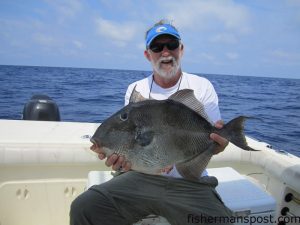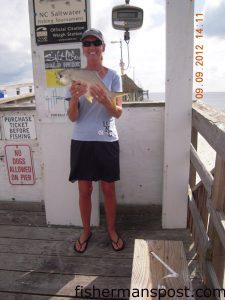Southport September 13, 2012

Bob McCarter, of Oak Island, with a 7 lb., 3 oz. triggerfish that he hooked on cut squid at some bottom structure 45 miles off Carolina Beach while he was fishing on the "Sarah's Worry." Weighed in at Island Tackle.
Steve, of The Tackle Box, reports that there’s been an excellent speckled trout bite in the area lately, despite somewhat dirty water. Most of the fish are falling for live shrimp on float rigs, and anglers are hooking them around inshore structure like docks and in the local creeks. Some black drum and sheepshead are also in the mix.
Red drum are feeding in the creeks, bays, and on the flats, and they will take an interest in live baits, Gulps and other soft plastics, topwater plugs, and a variety of other artificial lures.
Flounder are feeding all over the area. There’s still an excellent bite around nearshore structure like Yaupon and McGlamery Reefs when the seas let anglers get out to them. Inshore, anglers have been catching big numbers of keeper flatfish in the shallows of local creeks and bays and larger fish around structure like the Oak Island Bridge, Southport waterfront, and rocks and docks. Live finger mullet and menhaden are top choices for the flatfish, but anglers can also hook up on Gulp baits pinned to bucktail jigs or jigheads.
The spanish mackerel bite has slowed a bit, but anglers are still finding action with the spaniards around the inlets and along the beachfront wherever they can locate clean water. Trolling Clarkspoons behind planers is the best way to locate the fish, and anglers can also cast small metal jigs at them if they’re schooled up in numbers.
There’s a big amount of bait along the beaches right now, and with the week of north winds underway, it shouldn’t be long until some king mackerel make their way to the coast to start feeding on all the bait.
James, of Whatever’s Chewin’ Charters, reports that there’s been some excellent spanish mackerel action around the mouth of the Cape Fear River lately. The fish are feeding on schooled up bait during the first 2-3 hours of the falling tide, and anglers can locate the action by looking for working birds. Casting Sea Rock jigs into the melee has been very productive lately.

Theresa Short, of Cherryville, NC, with a 2 lb., 13 oz. pompano she hooked on shrimp off Oak Island Pier.
Big numbers of small “rat” red drum are on the feed in the lower Cape Fear, and anglers are hooking them on a variety of baits and lures (though live shrimp are particularly effective). In areas with a decent amount of current, anglers are finding some mid-slot reds mixed in with the juveniles. Small flounder are also feeding in the same areas and falling for live shrimp.
Sheepshead are looking for meals around hard structure like rocks and docks. Live shrimp or fiddler crabs are tough for the sheeps to turn down, and fishing them tight to the pilings or rocks is the way to go.
Angie, of Dutchman Creek Bait and Tackle, reports that anglers are hooking some spanish mackerel and bluefish around Lockwood Folly Inlet, both while trolling from boats and casting metal lures from the beachfront.
Some spot are starting to show up, and the tasty panfish should become more numerous as summer gives way to fall. Most anglers are hooking them from the Oak Island Piers on bottom rigs baited with shrimp and natural and artificial bloodworms.
Inshore, anglers are still finding plenty of action with flounder and red drum in the creeks, marshes, and around hard structure like docks. Live mud minnows, menhaden, or finger mullet will tempt bites from both inshore predators, and Gulp baits are also effective.
Tommy, of Oak Island Pier, reports that anglers are hooking a few solid (some 2+ lbs.) pompano from the pier. Most are falling for fresh shrimp, which are also appealing to some spot, sea mullet, croaker, and other panfish.
An excellent flounder bite has been going on lately as well, with some anglers taking home limits (and many fish 18-22”). Live finger mullet are producing most of the flounder action and are also tempting bites from some speckled trout.
